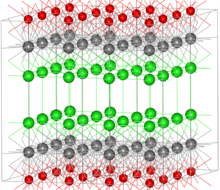Bismuth oxychloride
 | |
| Names | |
|---|---|
| Other names
bismuthyl chloride bismuth oxochloride bismuth oxide chloride bismuth(III) oxide chloride bismoclite | |
| Identifiers | |
| 7787-59-9 | |
| ChemSpider | 10606415 |
| |
| Jmol-3D images | Image |
| |
| UNII | 4ZR792I587 |
| Properties | |
| Molecular formula |
BiClO |
| Molar mass | 260.43 g·mol−1 |
| Density | 7.36 (meas.), 7.78 g/cm3 (calc.)[1] |
| insoluble | |
| Structure | |
| Crystal structure | Tetragonal, tP6[2] |
| Space group | P4/nmm, No. 129 |
| Lattice constant | a = 0.3887 nm, c = 0.7354 nm |
| Except where noted otherwise, data is given for materials in their standard state (at 25 °C (77 °F), 100 kPa) | |
| | |
| Infobox references | |
Bismuth oxychloride is an inorganic compound of bismuth with the formula BiOCl. It is a lustrous white solid, found naturally in the rare mineral bismoclite.
It is a component of some cosmetics, and has been used as such since antiquity, notably in ancient Egypt. Light wave interference from its plate-like structure of alternating layers of bismuth, oxygen, and chlorine atoms gives its suspensions a pearly iridescent light reflectivity similar to nacre.
Structure

BiOCl crystallises in the tetragonal space group P4/nmm. The crystal structure can be thought of as consisting of layers of Cl−, Bi3+ and O2− ions, in the order Cl-Bi-O-Bi-Cl-Cl-Bi-O-Bi-Cl. The bismuth atoms adopt a distorted square antiprismatic coordination geometry, with four chlorine atoms forming one of the square faces, each at a distance of 3.06 Å from Bi, and four oxygen atoms forming the other square face, each at a distance of 2.32 Å from Bi.
The oxygen atoms are tetrahedrally coordinated by four bismuth atoms.[2]
Synthesis and reactions
BiOCl is formed during the reaction of bismuth chloride with water, i.e. the hydrolysis:
- BiCl3 + H2O → BiOCl + 2 HCl
When heated above 600 °C, BiOCl converts to the Bi24O31Cl10, called the "Arppe compound" which has a complex layer structure.[3][4]
Use and occurrence
It has been used in cosmetics since the days of ancient Egypt. It is part of the "pearly pigment found in eye shadow, hair sprays, powders, nail polishes, and other cosmetic products".[5] Owing to the plate-like structure of the BiOCl, its suspensions exhibit optical properties like nacre.
BiOCl exists in nature as the rare mineral bismoclite, which is part of the matlockite mineral group.
An analogous compound, bismuth oxynitrate with nitrate ions in place of the chloride ions, bismuth oxynitrite, is known. It is used as a white pigment also. it is used a photocatalyst for degradation of organic pollutant
References
- ↑ Anthony, John W.; Bideaux, Richard A.; Bladh, Kenneth W. and Nichols, Monte C. (ed.). "Bismoclite". Handbook of Mineralogy (PDF). III (Halides, Hydroxides, Oxides). Chantilly, VA, US: Mineralogical Society of America. ISBN 0-9622097-2-4. Retrieved December 5, 2011.
- ↑ 2.0 2.1 Keramidas, K. G.; Voutsas, G. P.; Rentzeperis, P. I. (1993). "The crystal structure of BiOCl". Zeitschrift für Kristallographie 205 (Part-1): 35–40. doi:10.1524/zkri.1993.205.Part-1.35. ISSN 0044-2968.
- ↑ Greenwood, Norman N.; Earnshaw, Alan (1997). Chemistry of the Elements (2nd ed.). Butterworth-Heinemann. p. 572. ISBN 0080379419.
- ↑ Eggenweiler, U.; Keller, E.; Krämer, V. (2000). "Redetermination of the crystal structures of the `Arppe compound' Bi24O31Cl10and the isomorphous Bi24O31Br10". Acta Crystallographica Section B Structural Science 56 (3): 431–437. doi:10.1107/S0108768100000550. ISSN 0108-7681.
- ↑ Völz, Hans G. et al. "Pigments, Inorganic" in Ullmann's Encyclopedia of Industrial Chemistry, 2006 Wiley-VCH, Weinheim. doi:10.1002/14356007.a20_243.pub2.
| ||||||||||||